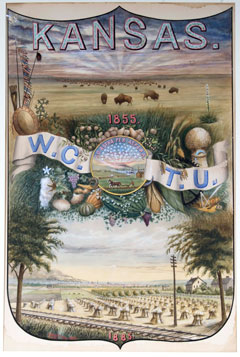June 4, 2019
Spring issue of Kansas History: A Journal of the Central Plains now available

The spring issue of Kansas History: A Journal of the Central Plains has been published and is now available through a partnership between the Kansas Historical Foundation and the Department of History at Kansas State University.
To get a copy, visit k-state.edu/history/kansas-history/ and subscribe today.
In the new issue:
Isaias J. McCaffery, "Fear, Politics, Myth, and Memory: Governor Thomas A. Osborn and the Osage Border War of 1874-75." In the summer of 1874, the new white settlements of the Gypsum Hills suffered from three afflictions. There was terrible drought, a related grasshopper plague, and frightening raids by bands of allied Cheyenne, Arapaho and Kiowa warriors. After an unknown party murdered four people near Medicine Lodge, Gov. Thomas A. Osborn stoked public panic, warning of Indian invasion to justify the hiring of hundreds of state militiamen as political patronage. Unwarned Osage buffalo hunters strayed into the imaginary war zone and four were shot and mutilated by an unauthorized posse. Gov. Osborn mustered these killers, retroactively, into the Kansas militia. These events triggered months of acrimonious dispute between the state and federal governments over the true facts surrounding the "Osage Border War." According to McCaffery, professor of history at Independence Community College, it is past time to correct the lingering misinformation generated in Topeka by "an administration open in its contempt for Indians and their rights." Published sources and internet websites still repeat erroneous anecdotes of Osage misdeeds disseminated by the partisan supporters of Gov. Osborn — the lingering output of political machinations long forgotten.
Charles F. Harris, "Affair in Circleville: The Strike on the Kansas Central Railway in the Aftermath of the Great Upheaval." In 1877 a national railroad strike swept across America. Known as the "Great Upheaval," the strike paralyzed the national transportation network, and resulted in millions of dollars in damage and over one hundred deaths. Kansas was largely spared from the impact of the strike until September 1877, explains Harris, a Wichita attorney and author. But narrow-gauge railway was being built from Leavenworth to Denver, and construction workers on the Kansas Central line at Circleville went on strike, preventing others from proceeding with the track. Capt. William Tough, a well-known Civil War scout and former Kansas Red Leg, was called in by the owners to deal with the strike. The posse led by Tough shot and killed the strike leader, and Tough was charged with murder. The shooting and subsequent controversy reflected the tension and conflict that existed between workers and owners during this period of rapid railroad expansion in Kansas.
Sarah Bell, "A Congress of Women: The Woman’s Council at the Ottawa Chautauqua, 1892-1914." In the late 19th century, the women's club movement in Kansas was growing rapidly. During the same time period, the cultural and educational movement called the Chautauqua, which started in western New York in 1874, expanded as independent assemblies started to form across the United States. Ottawa had one of the earliest Chautauqua assemblies in 1883, holding annual summer gatherings for over thirty years. Women were a primary audience for the Chautauqua from its beginning, but during the 1890s women started to use the platform to promote their interests, including political and social reforms. In 1892, the Ottawa Chautauqua started a Woman's Council, designed to be a physical gathering space and an intellectual center for the women's clubs of Kansas and western Missouri. Historian Bell argues the Woman's Council in Ottawa helped the women of Kansas change the political and social atmosphere of the state by hosting national suffrage leaders, advancing temperance and the state's Prohibition amendment, and playing a vital role in keeping clubwomen in communication about current events through the Chautauqua's monthly newspaper.
James N. Leiker, "'God created the earth, but he didn't finish things': Childhood Memories of Homesteading in Elma Bamberg's 'My Home on the Smoky.'" Elma spent her formative years on the plains of western Kansas during the last decade of the 19th century, lived to see the remarkable technological advances of the 20th century, and penned her unpublished, childhood memories, "My Home on the Smoky," during the 1960s. "Thus," as historian Leiker observes, there is "a distance of some 70 years between the events she lived as a child and the memories she recorded as an adult. . . . [but] the facts of time and revision do not necessarily diminish the historical value of Bamberg's memoir." As childhood pioneer narratives tend to do, it "undercuts much of the romance of agrarian life, providing negative details about deprivations, accidents, deaths, and other hardships often omitted in the nostalgic celebrations of adults." While it should not, of course, be taken entirely at face value, Bamberg's account, explains Professor Leiker, "provides an example of cultural memory, of the ways by which later generations tried to make sense of the homesteading experience, and consequently of themselves."
